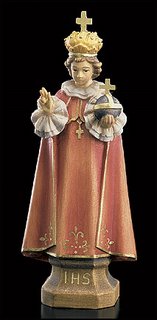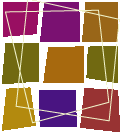BIG STATUES
St. Lucy’s Church and School in the Bronx was a traditional city parish that catered to its largely Italian base in the mid 1950s. And in the style typical of the time both buildings were adorned with large statues of various religious figures. Most of the statuary took the form of four foot or five foot plaster renderings of Jesus or of a few of the more popular saints. Sometimes the same saint was depicted several times each representing a different iconic pose.
As a young child, all the statues seemed larger than life. In fact, a four foot painted statue was larger than life to most St. Lucy School students. The statues' stationary placement in specific spots around the church and school made them familiar, silent guards for the many hallways and prayer coves throughout the large interior of both buildings, and it wasn't long before each of them went mostly unnoticed yet totally familiar. There were no identifying name plates on these statues, and all the men depicted as well as all the women had virtually the same, sweet, young, white European face. Identifying clues were revealed in the pose, the color of a veil, or the inclusion of some worldly element that spoke to the lives portrayed.
Jesus and the Blessed Virgin Mary were by far the figures most often represented in differing styles. Jesus was shown on the cross, of course, but also sitting reading to children gathered all around. He lay dying in His mother's arms, or stood majestically as the resurrected King. The Jesus depicted in the statue of The Infant of Prague was particularly distinct--especially when no school student ever knew who, what, or where "Prague" was. But they had an infant; that's all we knew. Jesus' color palette was strong on reds; that seemed to be a constant. His mother, Mary, owned the light blue palette. If the veil was baby blue, or the robe was blue, you were no doubt viewing some persona of Mary. If she was with a baby we called her the Madonna. We didn't know the difference between Mary Queen of Peace (a crown of jewels was the clue here) and the Immaculate Conception (white gown, blue robes), but we could tell the statues apart.
The many holy saints whose images were cast in plaster and painted with life-like precision were generally given but one set of identifiers. It was hard for the uninitiated to tell St. Anthony from St. Francis; both wore brown friar robes and had a ring of hair around the sides of his head, but we knew the secret: St. Anthony held a child, St. Francis had animals or birds nearby. St. Therese, the “Little Flower” was shown holding a bouquet, St. Bernadette was always depicted kneeling. Among the more unique saints was St. Jude. For some reason, he was always shown with a blazing fire coming out of the top of his head! As elementary school students we snickered at the image that no logic could ever explain.
But the most vivid and lasting memory of the big statues for me involved the patron saint of our school, St. Lucy herself. There, just inside the entrance stood a life-sized statue of the young woman who, legend has it, was tortured and subsequently killed for her faith centuries ago. Before her death her eyes were plucked out of her head. And there St. Lucy stood silently each day with one hand holding a plate. On that plate sat two ping-pong ball-sized orbs: plucked out eyeballs in a dish welcoming 5 and 6 and 7 year old children to school each day! We had no choice but to learn our daily lessons well at St. Lucy’s School.

